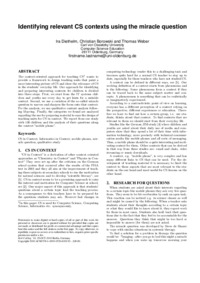Identifying relevant CS contexts using the miracle question Publikationsdatum:
Zu finden in: Koli Calling 2010, 2010
|
 |
 Diese Seite wurde seit 3 Jahren inhaltlich nicht mehr aktualisiert.
Unter Umständen ist sie nicht mehr aktuell.
Diese Seite wurde seit 3 Jahren inhaltlich nicht mehr aktualisiert.
Unter Umständen ist sie nicht mehr aktuell.
 Zusammenfassungen
Zusammenfassungen

The context-oriented approach for teaching CS wants to provide a framework to design teaching units that paint a more interesting picture of CS and show the relevance of CS in the students' everyday life. Our approach for identifying and preparing interesting contexts for children is divided into three steps: First, we start from the IT systems children and youths use every day to get hints for a suitable context. Second, we use a variation of the so-called miracle question to narrow and sharpen the focus onto that context. For the analysis, we use qualitative content analysis following Mayring. Finally, the categories we found are analyzed regarding the use for preparing material to ease the design of teaching units for CS in context. We report from our study with 130 children and the analysis of their questions along the context "mobile phone".
 The context-oriented approach for teaching CS wants to
provide a framework to design teaching units that paint a
more interesting picture of CS and show the relevance of CS
in the students' everyday life. Our approach for identifying
and preparing interesting contexts for children is divided
into three steps: First, we start from the IT systems children
and youths use every day to get hints for a suitable
context. Second, we use a variation of the so-called miracle
question to narrow and sharpen the focus onto that context.
For the analysis, we use qualitative content analysis following
Mayring. Finally, the categories we found are analyzed
regarding the use for preparing material to ease the design of
teaching units for CS in context. We report from our study
with 130 children and the analysis of their questions along
the context "mobile phone".
The context-oriented approach for teaching CS wants to
provide a framework to design teaching units that paint a
more interesting picture of CS and show the relevance of CS
in the students' everyday life. Our approach for identifying
and preparing interesting contexts for children is divided
into three steps: First, we start from the IT systems children
and youths use every day to get hints for a suitable
context. Second, we use a variation of the so-called miracle
question to narrow and sharpen the focus onto that context.
For the analysis, we use qualitative content analysis following
Mayring. Finally, the categories we found are analyzed
regarding the use for preparing material to ease the design of
teaching units for CS in context. We report from our study
with 130 children and the analysis of their questions along
the context "mobile phone". Dieses Konferenz-Paper erwähnt ...
Dieses Konferenz-Paper erwähnt ...
 Personen KB IB clear | mpfs Medienpädagogischer Forschungsverbund Südwest | ||||||||||||||||||
 Begriffe KB IB clear | Informatik-Unterricht (Fachinformatik)Computer Science Education
,  Kinder Kinder children
, children
,  Mobiltelefon Mobiltelefon mobile phone
, mobile phone
,  Unterricht Unterricht
| ||||||||||||||||||
 Bücher |
|
 Dieses Konferenz-Paper erwähnt vermutlich nicht ...
Dieses Konferenz-Paper erwähnt vermutlich nicht ... 
 Nicht erwähnte Begriffe | Bildung, Eltern, Informatik, Informatik-Didaktik, Informatikunterricht in der Schule, LehrerIn, Lernen, Schule |
 Tagcloud
Tagcloud
 Zitationsgraph
Zitationsgraph
 Zitationsgraph (Beta-Test mit vis.js)
Zitationsgraph (Beta-Test mit vis.js)
 3 Erwähnungen
3 Erwähnungen 
- Koli Calling 2013 - 13th Koli Calling International Conference on Computing Education Research, Koli Calling '13, Koli, Finland, November 14-17, 2013 (Mikko-Jussi Laakso, Simon) (2013)
- The use of code reading in teaching programming (Teresa Busjahn, Carsten Schulte) (2013)


- The use of code reading in teaching programming (Teresa Busjahn, Carsten Schulte) (2013)
- Tomorrow's Learning: Involving Everyone. Learning with and about Technologies and Computing - 11th IFIP TC 3 World Conference on Computers in Education, WCCE 2017, Dublin, Ireland, July 3-6, 2017 (Arthur Tatnall, Mary Webb) (2017)


- 56. What Teachers and Students Know About Data Management - Computer Science on the Schoolyard (Andreas Grillenberger, Ralf Romeike)


- 56. What Teachers and Students Know About Data Management - Computer Science on the Schoolyard (Andreas Grillenberger, Ralf Romeike)
- WiPSCE '21 - The 16th Workshop in Primary and Secondary Computing Education, Virtual Event / Erlangen, Germany, October 18-20, 2021 (Marc Berges, Andraes Mühling, Michal Armoni) (2021)
- What do Students Want to Know About the Digital World? - Investigating Students' Interest in CS through self-generated Questions (Stephan Napierala, Fatma Batur, Torsten Brinda) (2021)


- What do Students Want to Know About the Digital World? - Investigating Students' Interest in CS through self-generated Questions (Stephan Napierala, Fatma Batur, Torsten Brinda) (2021)
 Anderswo finden
Anderswo finden
 Volltext dieses Dokuments
Volltext dieses Dokuments
 |  Identifying relevant CS contexts using the miracle question: Fulltext at the ACM Digital Library ( Identifying relevant CS contexts using the miracle question: Fulltext at the ACM Digital Library ( : :  , 134 kByte; , 134 kByte;  : :  ) ) |
 Anderswo suchen
Anderswo suchen 
 Beat und dieses Konferenz-Paper
Beat und dieses Konferenz-Paper
Beat hat Dieses Konferenz-Paper während seiner Zeit am Institut für Medien und Schule (IMS) ins Biblionetz aufgenommen. Beat besitzt kein physisches, aber ein digitales Exemplar. Eine digitale Version ist auf dem Internet verfügbar (s.o.). Aufgrund der wenigen Einträge im Biblionetz scheint er es nicht wirklich gelesen zu haben. Es gibt bisher auch nur wenige Objekte im Biblionetz, die dieses Werk zitieren.









 Biblionetz-History
Biblionetz-History